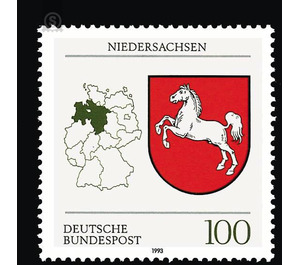Coat of arms of the Land of the Federal Republic of Germany (2) - Germany / Federal Republic of Germany 1993 - 100 Pfennig
Theme: Art & Culture
| Country | Germany / Federal Republic of Germany |
| Issue Date | 1993 |
| Face Value | 100.00 |
| Color | red white |
| Perforation | K 13 3/4 |
| Printing Type | Multicolor offset printing |
| Stamp Type | Postage stamp |
| Item Type | Stamp |
| Chronological Issue Number | 1535 |
| Chronological Chapter | GER-BRD |
| SID | 488881 |
| In 43 Wishlists | |
A white horse on a red background is the well-known heraldic animal of Lower Saxony. It has a history that began centuries before the founding of the state of Lower Saxony, which was only launched on November 1, 1946 by a decree of the British military government. Like the heraldic animal, the name Niedersachsen has a tradition of over 600 years. If the name is first recorded in a document in 1354, the horse appears as a heraldic sign only seven years later, in 1361, though without a causal connection. The Guelph Duke Albrecht II of Braunschweig-Grubenhagen broke with the tradition of his family to lead lions and leopards in the seal. He introduced a heraldic right-walking horse. He was followed very soon by other members of the split into several lines Welfenfamilie and also used the Rosses in their helmets over the traditional lion or leopard. The reason for this change was probably a political one. The dukes of Brunswick wanted to make clear in this way their special position in the area of the old Duchy of Saxony towards Emperor Charles IV., After this had 1356 in the Reich Basic Law of the Golden Bull the Wittenberg Askanier awarded the Electorate of Saxony. The change of the coat of arms of the Welfs was a deliberate recourse to more legendary old Saxon traditions and medieval arms saga: once the belief that the horse had been the tribal mark of the old Saxons (legend of the brothers Hengist and Horsa), on the other hand the assumption that the Saxon-Duke Widukind had led a black horse in the coat of arms, which turned into a white after his baptism. It was in the late Middle Ages as "Widukind's horse" and heraldic symbol. When in 1692 also the Welfenherzog Ernst August von Calenberg was awarded the honorary title, the horse changed from the Helmzier into the shield, where it would find its place in the top row of the twelve field grown Brunswick-Lüneburg coat of arms, framed by the two Brunswick Leopards and the Lüneburg Lion. The Saxon horse remained now coat of arms image of both the Electorate and the Kingdom of Hanover, but also the Duchy and the Free State of Braunschweig. Even after the Anschluss with Prussia in 1866, the Prussian province of Hanover retained its jumping white horse in the coat of arms. It had long become a symbol. After the Second World War, the new state was able to build on this coat of arms tradition, as the horse also had its place in the coat of arms of Braunschweig. Because it already represented four-fifths of the population of Lower Saxony at the time of its founding, it was initially unofficially the coat of arms of the new country formed by the states of Hanover, Brunswick, Oldenburg and Schaumburg-Lippe. The first Prime Minister of Lower Saxony, Hinrich Wilhelm Kopf, designated the horse as his coat of arms and, as early as 1946, hoisted a flag in front of the State Chancellery, showing the white Niedersachsen horse on a red background. The Diet confirmed this after detailed discussion on April 3, 1951. The law on coats of arms, flags, and seals of October 13, 1952 states: "The state of Lower Saxony has a white horse turned to the right as a coat of arms in the red field. The coat of arms has the shape of a round shield. «(Text: Lower Saxony Ministry of the Interior, Hanover)


